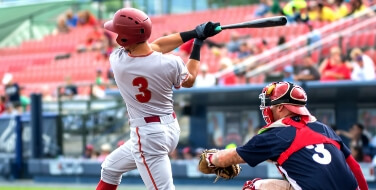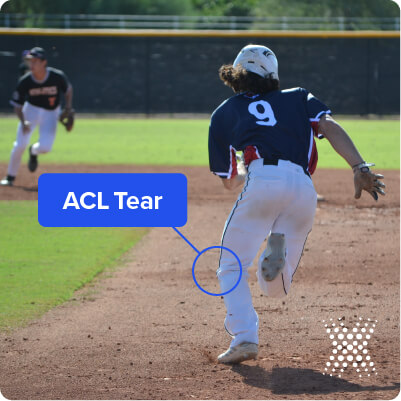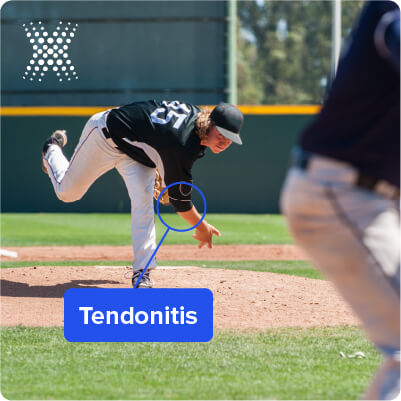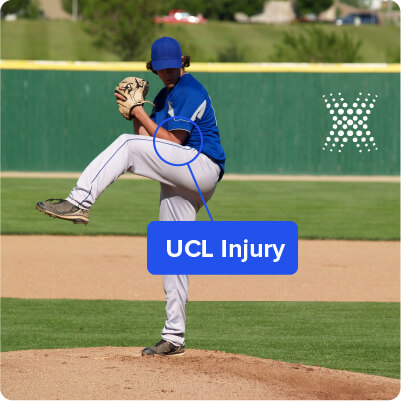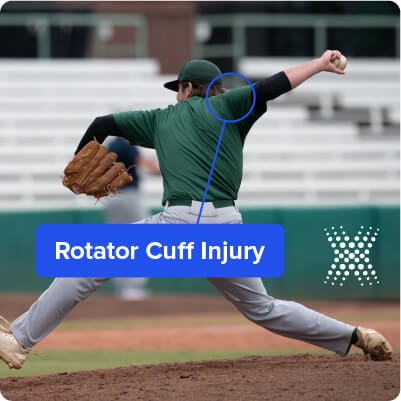Whether you are a baseball player yourself or you have a duty of care as a trainer or coach, you need to know about the types of injuries that are common in this popular sport.
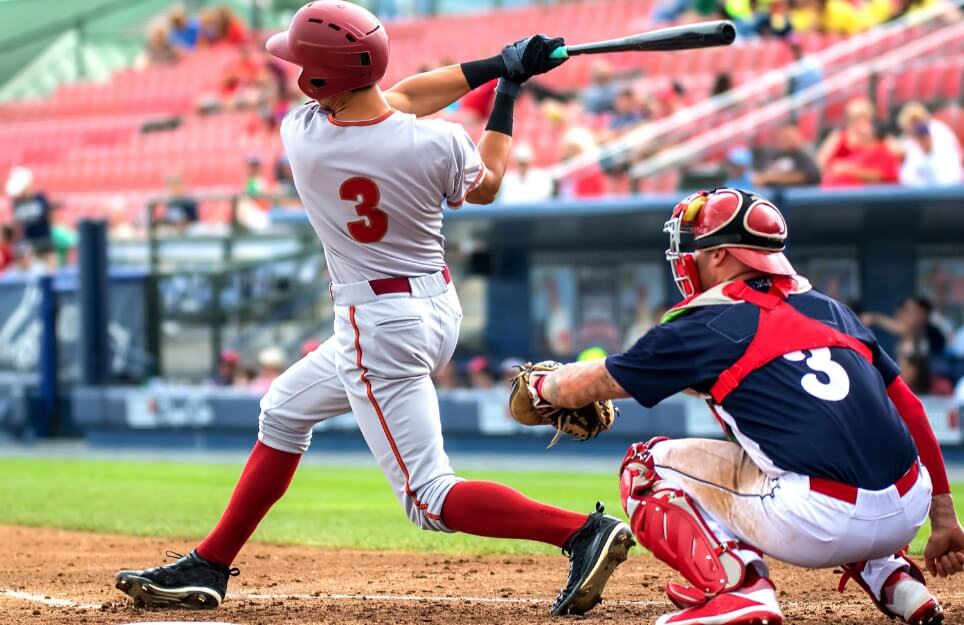
Within the below blog, you will find out everything there is to know about the 5 most common baseball injuries including their symptoms, causes and treatments.
Plus, find out how to prevent baseball injuries in the first place!
What are the Most Common Injuries in Baseball?
1. An ACL Tear
An ACL tear is a common baseball injury which affects the knee area. The anterior cruciate ligament (ACL) is one of the main ligaments inside your knee which joins the thigh bone to the front of your shin bone.
This sports injury typically occurs by playing sports that require you to quickly change direction or suddenly stop such as during baseball when you are base running and when you are swinging to hit the ball.
Some of an ACL tear symptoms include:
- A popping sound and a sudden pain in your knee.
- An inability to bear weight on your knee.
- Rapid swelling around the knee joint within an hour of the tear.
- A loss of range of movement in the knee.
This type of injury usually requires a visit to A&E and, depending on the severity of the tear, you may require physiotherapy, pain medication and possibly surgery. If you do require surgery, it can take between 6-12 months before you can return to full activity.
2. Tendonitis
Tendonitis is another common baseball injury that typically affects the area of the elbow, the rotary cuff or the shoulder. This baseball injury tends to occur due to the constant throwing of the baseball and the resulting stress that this action puts on the muscles.
When you throw a baseball, the muscles in the wrist, hand and shoulder are put under stress which means they are more likely to become inflamed. This in turn results in pain around the joints as well as stiffness.
In particular, pitchers are more likely to experience tendonitis as their arms undergo the most stress during each game.
Some of the most common symptoms of shoulder tendonitis in baseball players are:
- Pain in the middle of the shoulder joint and down the middle of the arm.
- Pain in the front of the shoulder deep into the rotary cuff.
- Pain in the front of the shoulder going down into the bicep.
- Pain in the back of the shoulder underneath the shoulder bone.
- Pain in the neck above the throwing shoulder.
Some of the most common symptoms of elbow tendonitis in baseball players are:
- Pain in the medial or inside of the elbow.
- Pain in the bicep where the muscle connects with the elbow joint.
- Pain on the outside of the elbow going over the top of the forearm.
Tendonitis is predominantly causes by overuse of a muscle and it won’t go away simply when you stop throwing. Instead, you need to rest, ice the affected area, apply compression, elevate the arm and focus on good nutrition.Strength training can also help to speed up your recovery, especially in the final stages when the muscle has nearly finished healing.
3. Torn Labrum
Often referred to as a baseball player’s most feared injury, almost half of all major leaguers do not return when they succumb to a torn labrum. Most commonly affecting batters, labral tears tend to occur in your non-dominant, leading shoulder which faces the pitcher.
Baseball batters generate a lot of torque which places stress on the shoulder. This can result in a torn labrum or shoulder dislocation. Once you experience this injury, you are at risk of dislocation occurring again even after a full recovery.
Depending on the severity of the tear, you may be advised to undergo physical therapy or surgery might be the best option.
In terms of recovery time, it is likely to take at least 3-4 months before the labrum is strong enough to start batting practice again and many surgeons advise staying away from the batting box until 6 months has passed.
4. UCL Injury
UCL injuries which affect the unilateral collateral ligament, most commonly affect pitchers. A type of overuse injury, stress on your UCL can occur from repetitive overhead movement or from a fall on an outstretched arm.
The UCL is the most common ligament injured from repetitive hand throwing which is why it is so prevalent in baseball players.
There are three grades of UCL injuries: Grade 1 where the ligament is stretched but not torn, Grade 2 where the ligament is stretched and may be martially torn and Grade 3 where the ligament is completely torn.
The most common symptoms of an UCL injury are:
- Pain and tenderness on the inner side of the elbow during or after an overhead arm activity.
- Pain with a fast forward movement of the arm.
- A weak or unstable feeling at the elbow.
- A weak hand grip.
- An inability to throw fast or hard.
In more severe cases, you may also experience:
- A sudden pop along the inside of your elbow.
- Severe pain.
- Complete inability to throw.
- Tingling and numbness in your pinkly and ring fingers.
The type of treatment you require, and the length of your recovery time will be dependent on the severity of your injury.
If you do not require surgery, then some of the most effective treatments include rest, anti-inflammatory medications, ice and physical therapy.
Surgical treatments for an UCL injury include UCL direct repair and UCL reconstruction. There is also promising stem cell research which could be a viable treatment or this type of injury.
5. Rotator Cuff Injury
As well as tendonitis, your rotator cuffs can also succumb to more serious injuries which may require surgery to repair.
Rotator cuff injuries in baseball are most common in baseball pitchers as they are caused by repeated overhead throwing at high speeds.
One of the most common rotary cuff injuries is a rotary cuff tear which typically occurs over time from the wear and tear and repeating the same arm motion. A rotary tear is a serious type of injury that has the potential to shorten your season or even end your career entirely.
If you require an operation to fix a rotary cuff tear, it can take around 3 months to heal and between 9-12 months before you can start playing again.
Some of the most common signs of a rotary cuff tear include:
- Pain when you raise your arm.
- Difficulty raising your arm.
- A popping or clicking sound or sensation when you move your arm.
- Shoulder pain that is worse at night.
- A weakened shoulder.
- Recurrent pain, especially with certain activities that require you to lift your arm.
How to Recover from Baseball Injuries
As mentioned briefly above, the time it takes to recover from a baseball injury and the treatment needed is dependent upon the type of injury and its severity.
For minor injuries that do not require a surgical procedure, often rest, elevation and icing are all that is needed to make a full recovery. However, if you have a severe injury that requires surgery and ongoing physical therapy, your recovery time will be a lot longer.
If you are eager to avoid surgery and the lengthy recovery time that goes hand in hand with it, there is an alternative. Stem cell therapy for sports injuries has come along way in recent years and has the ability to dramatically reduce your recovery time, as well as help to prevent future injuries.
Stem cell therapies can be used to treat an extensive range of baseball injuries including all of the ones mentioned above. It is also highly effective at eliminating chronic pain.
How to Prevent Baseball Injuries
When it comes to preventing baseball injuries, there are several effective strategies that you can adopt:
Always Warm-Up
A crucial aspect of injury prevention, you must always make sure that you take the time to properly warm up before a game or training session. Warm-ups are designed to get your heart pumping and to increase the flow of blood around your body. They also help to warm up and stretch the muscles which is crucial in the prevention of injuries.
A baseball warm-up should consist of at least 5 minutes of moderate intensity cardio as well as exercises that are designed to get your heart rate up such as skipping or cycling. This should be followed by a series of dynamic stretches.
Invest in Protective Equipment
In baseball, protective equipment is a must, especially for catchers. More specifically, a helmet with a face guard, a chest protector, throat protector, legs guards and catching mitts are essential.
Batters also require a helmet and batting gloves, as well as the option to wear padded shorts and a cup.
Rest and Recover
One of the easiest ways to avoid baseball injuries, or any sports-related injury, is to make sure you give the body adequate time to rest. As many baseball injuries are overuse injuries, resting is essential as it allows the muscles and joints to heal.
Taking adequate time to rest is particularly important if you have experienced a specific injury before as you are more likely to succumb to this again if you overexert yourself.
